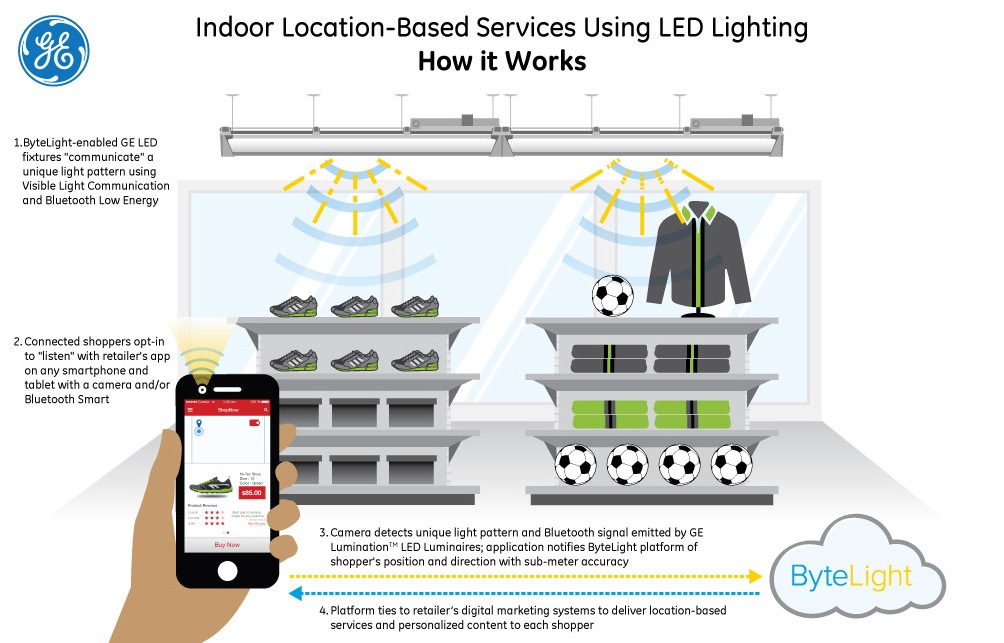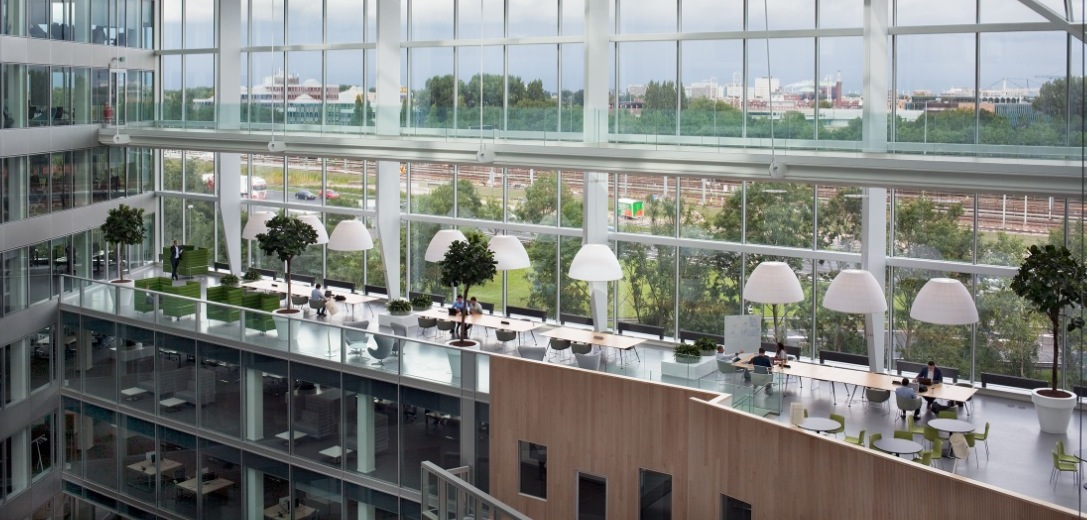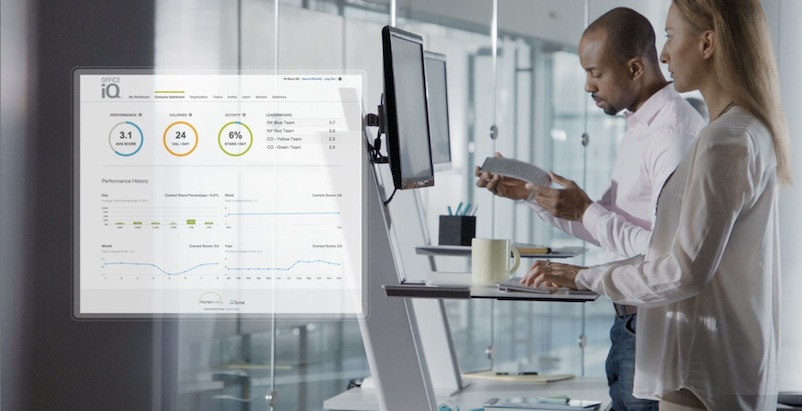CallisonRTKL has been working on a museum project in the Northeast where the Internet of Things (IoT) is part of the conversation about improving the building’s energy and operational efficiency, as well as its visitor and employee comfort.
The client was already on board about connecting sensors that monitor the museum’s MEP and HVAC systems, “and wanted to know how it might benefit more” from interconnectivity, recalls Michael Colburn, Associate and Designer with CallisonRTKL’s Technology Design Studio. So the firm incorporated integrated building technologies into the design. When an employee enters the building and “badges in,” the access control system will adjust the temperature and lighting, as well as raise or lower the shades, in that person’s office. The system also turns on switch-controlled outlets, which are turned off when the employee leaves the building.
CallisonRTKL and its client are tapping into the concept of IoT that has actually been around a while. For more than a decade, New York-based CytexOne has been guiding developers toward interconnectivity as a means of elevating their properties’ operations and productivity. The ZigBee Alliance, a nonprofit association with about 450 members, has been promoting its namesake’s open wireless standard for connecting everyday devices since 2002.
What’s stirring up all the excitement and hype about IoT’s transformative potential now are the advances in and ubiquity of smartphone, fiber-optic, and WiFi technologies and installations, coupled with analytical software that, at lightning speed, can make sense of the reams of Big Data aggregated from these devices. This combination is uncovering new insights into human, mechanical, and infrastructure behaviors and patterns.
 The office environment is where many AEC and tech experts believe the Internet of Things is having the greatest immediate impact. OfficeIQ, a system devised by Humanscale and Tome Software, uses sensors installed on adjustable workstations and chair casters to track how furniture and rooms are being used.
The office environment is where many AEC and tech experts believe the Internet of Things is having the greatest immediate impact. OfficeIQ, a system devised by Humanscale and Tome Software, uses sensors installed on adjustable workstations and chair casters to track how furniture and rooms are being used.
A host of IoT apps has emerged, many of them aimed at abetting facilities management. Anyone who wonders about the significance of this trend needs to look no further than the tech giants Apple, Samsung, and Google, each of which is refining its own IoT platform.
“Everything IoT is about enhancing how we engage with the user, and how the user responds to the space,” says Alan Robles, Associate and Experience Designer with Gensler’s Retail Group. “It is both passive and active, and allows us to create a broader palette and more effective space.”
But Robles and other AEC and tech experts caution that while data being generated by devices are voluminous, most “things” still aren’t set up to communicate with each other. As devices remain siloed, so too do buildings, which makes it tougher for urban planners to deploy IoT solutions to draw conclusions from patterns and behaviors as a means toward more habitable and better-run cities.
BRAINY OFFICES GUIDE EMPLOYEE ACTIVITY
On the AEC front, it appears that retail and healthcare are actively contemplating IoT-driven futures. “Retail is at the top of the list, as a survival strategy against e-commerce,” observes Colburn. “And healthcare wants to personalize the patient experience” to achieve higher satisfaction scores.
The ecosystem of things, communication, applications, and data analysis that IoT comprises appears to be finding its fullest expression in office spaces. David Karpook, Strategic Business Consultant with Planon, a Seattle-based company that specializes in workplace optimization, explains that many offices have either too few or too many meeting rooms, and they are usually the wrong sizes. Sensing devices “give you an understanding of how many people are actually showing up for meetings,” and that information can inform developers and Building Teams when they adjust spaces in current and future buildings.
Ben Waber thinks too many corporate decisions about managing space and employees are made “by people trying to emulate some business they read about in Harvard Business Review.” Boston-based Humanyze, which Waber co-founded and is its President and CEO, shows companies how to help employees set goals using data collected by ID badges embedded with sensor technology devised by the MIT Media Lab. The sensors capture face-to-face interactions and, when combined with other productivity metrics, provide insight into how an organization is functioning, and might work better.
At the recent Consumer Electronics Show in Las Vegas, Humanscale, which specializes in workplace design, and Tome Software launched OfficeIQ, a connected workspace solution that equips adjustable workstations with occupancy and height sensors as a means of helping companies monitor how those stations are used and to help employees make healthy choices throughout the day.
“This is just the beginning” toward an active, intelligent workplace, predicts Chris Gibson, Humanscale’s VP of Marketing and Product Management.
 "Smart" lighting transforms retail: GE partnered with ByteLight to launch a line of “smart” LED light fixtures that can deliver custom, location-based content and services to shoppers.
"Smart" lighting transforms retail: GE partnered with ByteLight to launch a line of “smart” LED light fixtures that can deliver custom, location-based content and services to shoppers.
Perhaps the most elaborate—and, to some, Orwellian—manifestation of IoT in an office environment is The Edge, a 430,000-sf tower that, when it opened in Amsterdam last June, was immediately dubbed the smartest building in the world. The building’s main tenant, Deloitte, provides its 2,500 employees with a smartphone app that, according to BloombergBusiness, from the minute they wake up checks their schedules, recognizes their cars and directs them to an open parking space, assigns them a desk (there are only 1,000 in the building), and adjusts the temperature and lighting to their preferences.
The Edge’s central nervous system is stimulated by 28,000 sensors, from which Deloitte captures extensive data on how its employees interact. Even the hand dryers in the bathrooms are connected to the Internet to let the janitorial staff know when cleanup is needed.
This level of reconnaissance inevitably raises questions about worker privacy and security. Humanscale and Humanyze insist they don’t share individual data with employers, just aggregate information. But privacy concerns about IoT aren’t going away. Many companies are watching the outcome of a lawsuit filed last year by a woman in California who claims she was fired for deleting an app on a company-issued smartphone that she claimed allowed her employer, Intermex, to monitor her activities, even when she wasn’t working.
CRACKING OPEN URBAN SILOS
The Edge, writ large, is how IoT proponents envision cities coalescing. Gartner, with one of the largest IoT practices among research firms, predicts 1.6 billion connected things will be used by “smart cities” this year, a 39% increase from 2015. Commercial buildings are expected to account for 518 million of those connected things.
Gartner’s definition of a smart city is one where multiple sectors cooperate to achieve sustainable outcomes through the analysis of data shared among sector-specific informational and operational technology systems. Dean Freeman, Gartner’s VP of Research, tells BD+C that interconnectivity is occurring robustly in newer and expanding metros in Asia and the Middle East. The highest penetration of 4G today is in the United Arab Emirates, where Dubai is integrating IoT into users’ daily lives, as well as its municipal departments. It is on pace to become the world’s smartest city within three years, according to Anil Menon, Global President of Cisco’s Smart+Connected Communities business.
 Dubbed the world’s smartest building when it opened in Amsterdam last summer, The Edge, a 430,000-sf office tower, is equipped with 28,000 sensors that allow its main tenant, Deloitte, to manage its employees’ daily activities, and give those employees greater control of their workplace environments. The building is distinguished by a 15-story atrium where every workspace is within 23 feet of a window and views. Photo: Raimond Wouda, courtesy PLP Architecture. Click photo to enlarge.
Dubbed the world’s smartest building when it opened in Amsterdam last summer, The Edge, a 430,000-sf office tower, is equipped with 28,000 sensors that allow its main tenant, Deloitte, to manage its employees’ daily activities, and give those employees greater control of their workplace environments. The building is distinguished by a 15-story atrium where every workspace is within 23 feet of a window and views. Photo: Raimond Wouda, courtesy PLP Architecture. Click photo to enlarge.
IoT can be more difficult in older cities, Freeman observes, where buildings mostly operate autonomously.
But that could be changing, too. Corporate giants AT&T, Cisco, Ericsson, Intel, Qualcomm, IBM, Deloitte, and GE are collaborating, with support from federal agencies, to develop a new framework for smart cities that will make it easier for communities to be more connected. The consortium, reports Fierce Wireless, will use three U.S. metros—Atlanta, Chicago, and Dallas—as its first test-bed cities for the platform.
AT&T is also developing a digital dashboard, called the Smart City Network Operation Center, which will give cities a real-time view of problems like power outages, water leaks, and traffic congestion. Last June, Sprint said it would deploy hardware from Cisco to construct, own, and manage an intelligent WiFi network as part of a smart city deployment in downtown Kansas City, Mo.
MANDATES ON THE HORIZON?
Freeman sees insurers and the government as the catalysts that will drive IoT solutions. In California, codes already mandate lighting and plug-load levels, “and are going to drive a lot more once the now CO2 regs come out.” Insurers, he adds, will demand that buildings be wired to spot systems hiccups before they become massive and costly breakdowns.
Planon’s Karpook believes the construction and renovation projects that succeed going forward are those that focus on specific data sets, but also are open to allowing new data “to come in along the edges.” This is where learning machines come into play.
Colburn sees interconnected buildings and smarter cities as inevitable, especially where leadership and grassroots agendas are in sync. “The game change will be when someone takes the reins to make these things work together and make experiences better,” he says.
To participate in this process, AEC firms, says Colburn, must step up to design these experiences by “wrapping systems into simple, commissionable” packages.
Related Stories
AEC Tech | May 9, 2023
4 insights on building product manufacturers getting ‘smart’
Overall, half of building product manufacturers plan to invest in one or more areas of technology in the next three years.
Sustainability | May 1, 2023
Increased focus on sustainability is good for business and attracting employees
A recent study, 2023 State of Design & Make by software developer Autodesk, contains some interesting takeaways for the design and construction industry. Respondents to a survey of industry leaders from the architecture, engineering, construction, product design, manufacturing, and entertainment spheres strongly support the idea that improving their organization’s sustainability practices is good for business.
AEC Tech | May 1, 2023
Utilizing computer vision, AI technology for visual jobsite tasks
Burns & McDonnell breaks down three ways computer vision can effectively assist workers on the job site, from project progress to safety measures.
AEC Tech Innovation | Apr 27, 2023
Does your firm use ChatGPT?
Is your firm having success utilizing ChatGPT (or other AI chat tools) on your building projects or as part of your business operations? If so, we want to hear from you.
Design Innovation Report | Apr 19, 2023
HDR uses artificial intelligence tools to help design a vital health clinic in India
Architects from HDR worked pro bono with iKure, a technology-centric healthcare provider, to build a healthcare clinic in rural India.
Resiliency | Apr 18, 2023
AI-simulated hurricanes could aid in designing more resilient buildings
Researchers at the National Institute of Standards and Technology (NIST) have devised a new method of digitally simulating hurricanes in an effort to create more resilient buildings. A recent study asserts that the simulations can accurately represent the trajectory and wind speeds of a collection of actual storms.
3D Printing | Apr 11, 2023
University of Michigan’s DART Laboratory unveils Shell Wall—a concrete wall that’s lightweight and freeform 3D printed
The University of Michigan’s DART Laboratory has unveiled a new product called Shell Wall—which the organization describes as the first lightweight, freeform 3D printed and structurally reinforced concrete wall. The innovative product leverages DART Laboratory’s research and development on the use of 3D-printing technology to build structures that require less concrete.
Smart Buildings | Apr 7, 2023
Carnegie Mellon University's research on advanced building sensors provokes heated controversy
A research project to test next-generation building sensors at Carnegie Mellon University provoked intense debate over the privacy implications of widespread deployment of the devices in a new 90,000-sf building. The light-switch-size devices, capable of measuring 12 types of data including motion and sound, were mounted in more than 300 locations throughout the building.
Architects | Apr 6, 2023
New tool from Perkins&Will will make public health data more accessible to designers and architects
Called PRECEDE, the dashboard is an open-source tool developed by Perkins&Will that draws on federal data to identify and assess community health priorities within the U.S. by location. The firm was recently awarded a $30,000 ASID Foundation Grant to enhance the tool.
AEC Tech | Mar 14, 2023
Skanska tests robots to keep construction sites clean
What if we could increase consistency and efficiency with housekeeping by automating this process with a robot? Introducing: Spot.

















